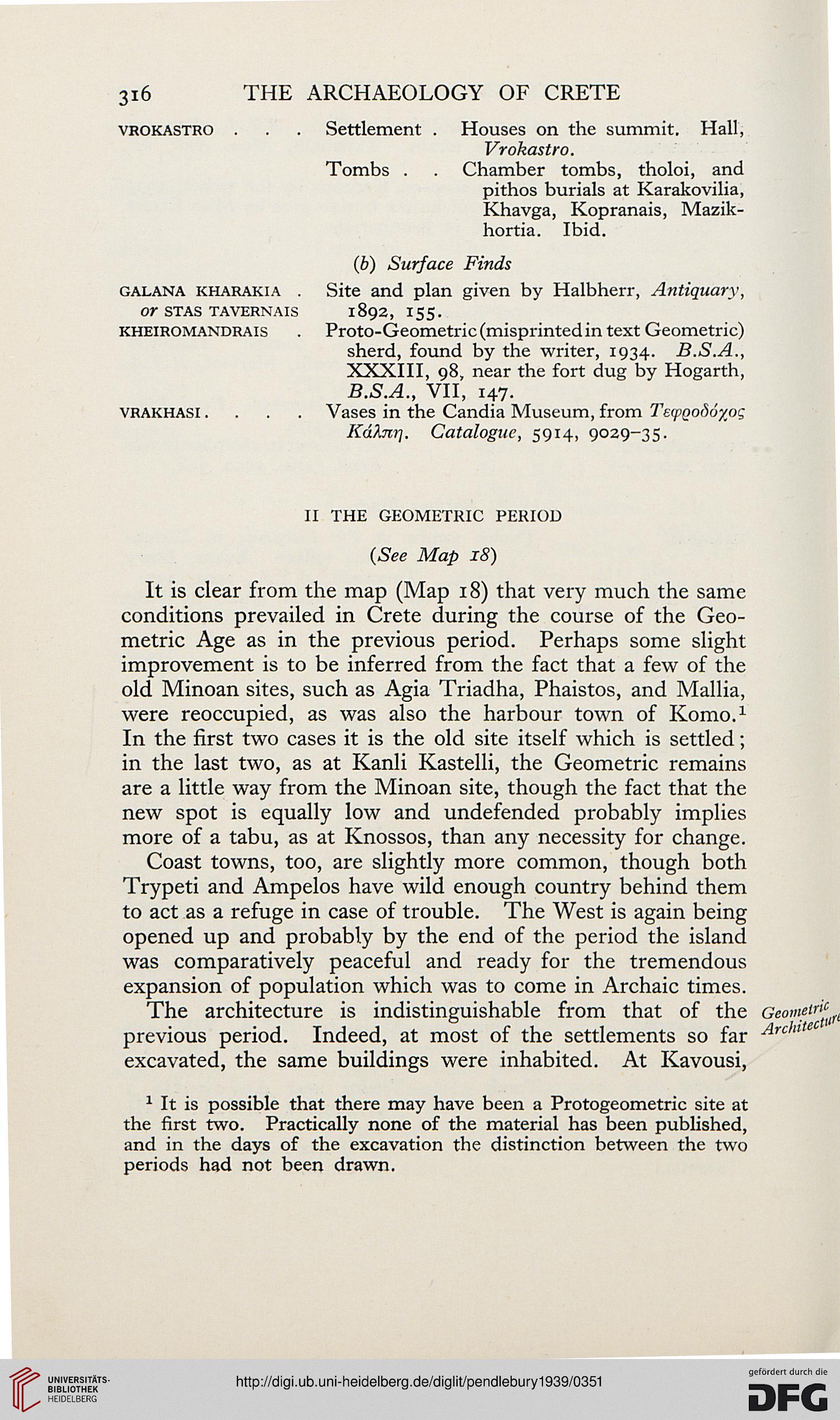316
VROKASTRO
GALANA KHARAKIA .
Or STAS TAVERNAIS
KHEIROMANDRAIS
VRAKHASI .
THE ARCHAEOLOGY OF CRETE
Settlement . Houses on the summit. Hall,
Vrokastro.
Tombs . . Chamber tombs, tholoi, and
pithos burials at Karakovilia,
Khavga, Kopranais, Mazik-
hortia. Ibid.
(b) Surface Finds
Site and plan given by Halbherr, Antiquary,
1892, 155.
Proto-Geometric (misprinted in text Geometric)
sherd, found by the writer, 1934. B.S.A.,
XXXIII, 98, near the fort dug by Hogarth,
B.S.A., VII, 147.
Vases in the Candia Museum, from TeipQol)6yog
Kdhtr\. Catalogue, 5914, 9029-35.
II THE GEOMETRIC PERIOD
(See Map 18)
It is clear from the map (Map 18) that very much the same
conditions prevailed in Crete during the course of the Geo-
metric Age as in the previous period. Perhaps some slight
improvement is to be inferred from the fact that a few of the
old Minoan sites, such as Agia Triadha, Phaistos, and Mallia,
were reoccupied, as was also the harbour town of Komo.1
In the first two cases it is the old site itself which is settled;
in the last two, as at Kanli Kastelli, the Geometric remains
are a little way from the Minoan site, though the fact that the
new spot is equally low and undefended probably implies
more of a tabu, as at Knossos, than any necessity for change.
Coast towns, too, are slightly more common, though both
Trypeti and Ampelos have wild enough country behind them
to act as a refuge in case of trouble. The West is again being
opened up and probably by the end of the period the island
was comparatively peaceful and ready for the tremendous
expansion of population which was to come in Archaic times.
The architecture is indistinguishable from that of the
previous period. Indeed, at most of the settlements so far
excavated, the same buildings were inhabited. At Kavousi,
1 It is possible that there may have been a Protogeometric site at
the first two. Practically none of the material has been published,
and in the days of the excavation the distinction between the two
periods had not been drawn.
VROKASTRO
GALANA KHARAKIA .
Or STAS TAVERNAIS
KHEIROMANDRAIS
VRAKHASI .
THE ARCHAEOLOGY OF CRETE
Settlement . Houses on the summit. Hall,
Vrokastro.
Tombs . . Chamber tombs, tholoi, and
pithos burials at Karakovilia,
Khavga, Kopranais, Mazik-
hortia. Ibid.
(b) Surface Finds
Site and plan given by Halbherr, Antiquary,
1892, 155.
Proto-Geometric (misprinted in text Geometric)
sherd, found by the writer, 1934. B.S.A.,
XXXIII, 98, near the fort dug by Hogarth,
B.S.A., VII, 147.
Vases in the Candia Museum, from TeipQol)6yog
Kdhtr\. Catalogue, 5914, 9029-35.
II THE GEOMETRIC PERIOD
(See Map 18)
It is clear from the map (Map 18) that very much the same
conditions prevailed in Crete during the course of the Geo-
metric Age as in the previous period. Perhaps some slight
improvement is to be inferred from the fact that a few of the
old Minoan sites, such as Agia Triadha, Phaistos, and Mallia,
were reoccupied, as was also the harbour town of Komo.1
In the first two cases it is the old site itself which is settled;
in the last two, as at Kanli Kastelli, the Geometric remains
are a little way from the Minoan site, though the fact that the
new spot is equally low and undefended probably implies
more of a tabu, as at Knossos, than any necessity for change.
Coast towns, too, are slightly more common, though both
Trypeti and Ampelos have wild enough country behind them
to act as a refuge in case of trouble. The West is again being
opened up and probably by the end of the period the island
was comparatively peaceful and ready for the tremendous
expansion of population which was to come in Archaic times.
The architecture is indistinguishable from that of the
previous period. Indeed, at most of the settlements so far
excavated, the same buildings were inhabited. At Kavousi,
1 It is possible that there may have been a Protogeometric site at
the first two. Practically none of the material has been published,
and in the days of the excavation the distinction between the two
periods had not been drawn.





